Modules for tobacco & nicotine education

Our new You and Me, Together Vape-Free curriculum , which is part of the Stanford Tobacco Prevention Toolkit , is a 6-lesson evidence-based curriculum created by the Stanford REACH Lab as well as by our Youth Action Board, educators, healthcare providers, and scientists across the U.S.
All of our lessons are mapped to the California and National Common Core State Standards, Health Education Content Standards, and the National Health Education Standards . Please see the links within each Lesson to see the Standards associated with each lesson.
Navigate to each lesson by clicking the thumbnail. We offer elementary, middle and high school versions as well as other languages/cultures down below.

Please register to our data dashboard platform below, before beginning the curriculum!
If you have registered before for another curriculum or grade, simply login to obtain your data collection code.
For Elementary Schools (Click here to view lessons)
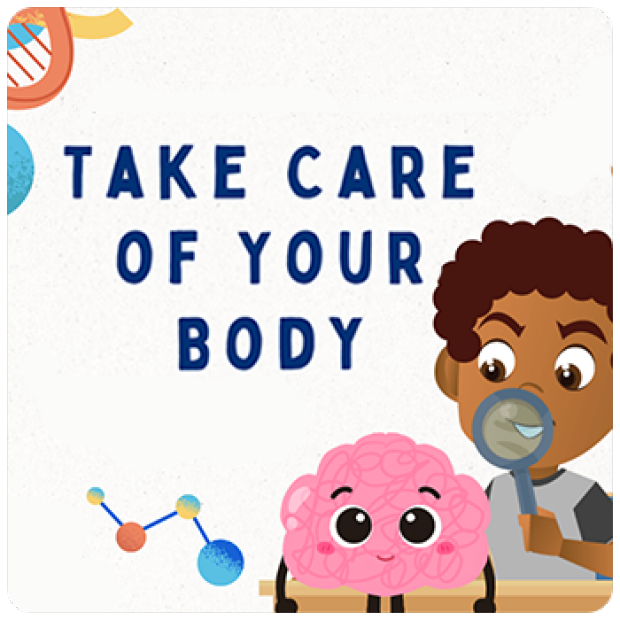
For Middle Schools (Click here to view lessons)

For High Schools (Click here to view lessons)
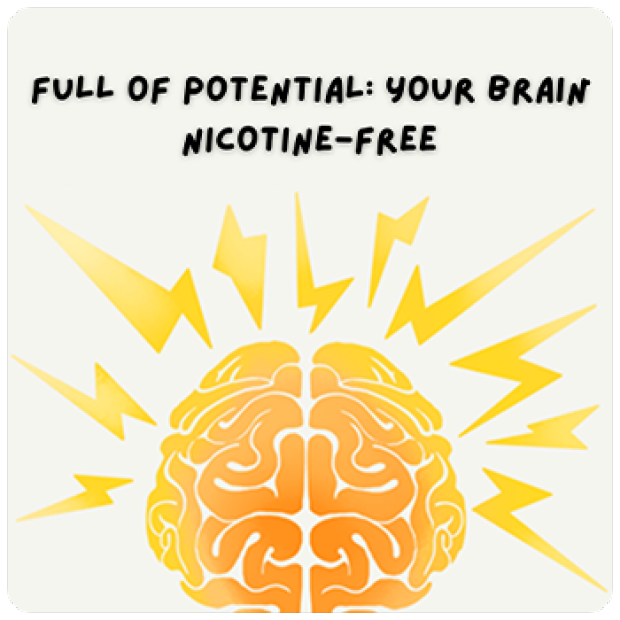
- General Info

Using Canva
- Pre/Post-Surveys
- Parent Letter
- Crash Courses for Instructors
- Different Cultures/Lang.
Introduction to the Curriculum and General Information
The You and Me, Together Vape-Free curriculum includes a middle and high school program that are 6 lessons, approximately 50 minutes each. It also includes a two-lesson elementary school version , approximately 50 minutes each. Every lesson provides activities , online quiz games , and worksheets in addition to presentations , resources , and other materials aimed at addressing key factors associated with youth e-cigarette use, including changing adolescents’ attitudes towards and misperceptions about e-cigarettes; increasing their refusal skills to pulls of flavors, marketing, and social media; reducing stress and depression which have been linked to e-cigarette initiation and use; improving coping; and decreasing intentions and actual use of all e-cigarette products.
These 6 in-class sessions are reinforced outside of the classroom with follow-up discussion guides that provide open-ended questions and activities for youth to discuss various e-cigarette-related topics with a trusted adult and/or peer in order to open dialogue between youth and adults. The curriculum is meant to reach all youth, including those at highest risk of tobacco use, racial/ethnic minorities, students in continuation and alternative schools, and those identifying as LGBTQ+.
The goals of this curriculum are for adolescents to:
Increase their knowledge about e-cigarettes and the harms they can cause .
Gain awareness of strategies manufacturers and sellers of e-cigarettes employ to increase use among adolescents, such as deceptive and creative marketing strategies ., gain skills to refuse experimentation and use of e-cigarettes ., ultimately, to reduce and prevent e-cigarette use of any type, including nicotine, cannabis/thc, and/or non-nicotine products., before getting started, here are a few notes to review:.
- Each lesson has a lesson page that provides background information, learning objectives, key takeaways the students will learn, health education and common core standards (both California and National) addressed in each lesson. Each lesson also includes direct links to the Canva slides, talking points, a Kahoot quiz, and a Discussion Guide.
- All lessons may require some prep work for activities (gathering materials, setting up the class), optional slides (preview optional videos and activities to see if they are right for your class), and determining additional activities (found at the bottom of each lesson page). Please review each lesson's notes before implementing.
- Notes (a.k.a. "script") that can be used for each slide are embedded in the Canva slides as well as can be found in the teacher Talking Points Chart.
- Each unit has a Kahoot! Quiz linked below and can be used as a pre and post quiz to see how much students know before and after instruction.
- Discussion Guides: We suggest providing students with the discussion guide that they can take home and discuss with a trusted adult such as a parent/caregiver, coach, mentor, and/or a peer. The discussion guide for this lesson is available to either download or print home.
In order to create new, more animated and more exciting slides, we are now using Canva slides for each lesson.
We would like to encourage you to set up your free Canva Pro account! Link here for educators to set up their free account.
Educators who have a free or pro account with Canva will be able to:
- See the slides and talking points in the notes section.
- Make a copy and save slides to add personal adjustments.
- Share the slides with anyone who has or doesn't have a Canva account.
- Download the slides as PDF, PowerPoint or Video (depending on if the lesson includes videos).
To download your Canva presentation in PowerPoint format:
- Tap on the Microsoft PowerPoint option.
- Click the Download button on the dialog box.
Educators who want to download slides and import them into google slides please read the following:
Educators who don't have a free or pro account with canva:.
Will be able to view the slides without accessing the talking points, in which case you'll still have access to the talking points via Lesson Plan Mastersheet. We suggest teachers at least create a free account to have better accessibility to the slides.
Warm-up Activity
Before diving into the lessons, we suggest a couple of warm-up activities with your students!
Warm-up Activity 1

- E-cigarettes have many different names: e-cigs, vapes, vape pens, Juul and so on.
- Ask students to shout out different names , but then explain that this curriculum will use the term e-cigarettes as they are a form of cigarettes and not a water vapor.
- Optional: Utilizing our printable worksheets , have students quietly write down different names for e-cigarettes and where they have seen them .
Warm-up Activity 2

- Ask students to shout out what they know and what they want to know about e-cigarettes . Consider writing down what the students say, on paper, a white board, or a slide - whatever you prefer. Then, at the end of the curriculum, review what was said before and what was covered, and correct misperceptions.
- Optional: Utilizing our printable worksheets , have students quietly write down what they know about e-cigarettes and what they want to know.
Pre- and Post- Surveys
Before getting started:.
Please register on our data dashboard platform below before beginning the curriculum! If you have registered before for another curriculum or grade, simply login to obtain your data collection code (teacher code).
Our dashboard helps educators obtain real-time data through short pre- and post-surveys on students' gained knowledge and intentions.
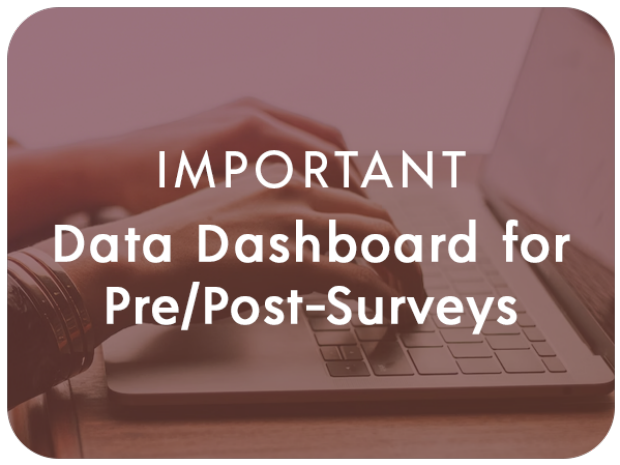
(BEFORE you teach any of the lessons)
Click the image below, right click to save on your computer to give to your students. Or simply give them the link below the QR code!
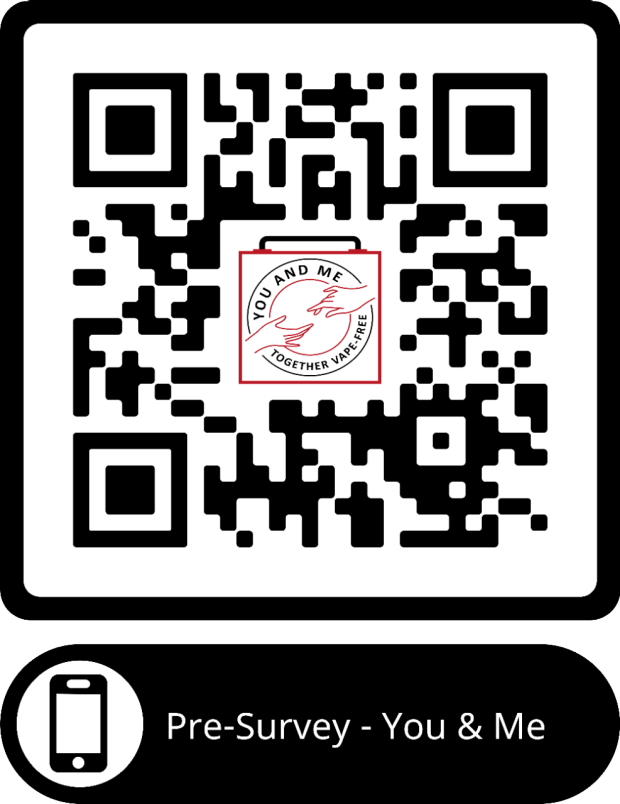
qrco.de/behk6D
Post-survey.
(AFTER you teach any number of the lessons)
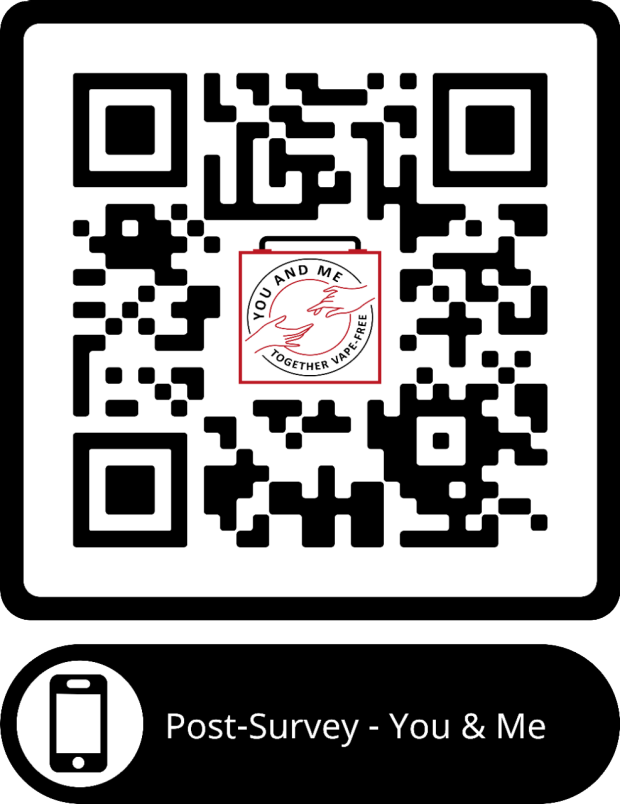
qrco.de/behk7d
Letter to parents.
If you would like to send a letter home to parents regarding this curriculum, please preview and download/print below.
Preview Parent Letter
<<EDUCATORS:FEEL FREE TO ADD YOUR LETTERHEAD>>
<<Today’s Date>>
Dear Parent or Caregiver,
As you probably know, e-cigarette use (also known as vaping) among students has reached epidemic proportions. Students are using e-cigarettes with nicotine, cannabis, and other products.
<<Next week or on * dates>> , students will begin learning about e-cigarettes through Stanford’s “You and Me Together Vape Free.”
This new curriculum, You and Me, Together Vape-Free curriculum, is part of the Stanford Tobacco Prevention Toolkit, is a theory-based and evidence-informed curriculum created by the Stanford Reach Lab as well as by youth, educators, and scientists across the U.S.
· Increase their knowledge about e-cigarettes and the harms they can cause.
· Gain awareness of strategies manufacturers and sellers of e-cigarettes employ to increase use among adolescents, such as deceptive and creative marketing strategies.
· Gain skills to refuse experimentation and use of e-cigarettes.
· Ultimately, to reduce and prevent e-cigarette use of any type, including nicotine, cannabis/THC, and/or non-nicotine products. The You and Me, Together Vape-Free curriculum includes 6 lessons, each providing activities, online quiz games, and worksheets in addition to presentations, resources, and other materials aimed at addressing key factors associated with youth e-cigarette use, including changing adolescents’ attitudes towards and misperceptions about e-cigarettes; increasing their refusal skills to pulls of flavors, marketing, and social media; reducing stress and depression which have been linked to e-cigarette initiation and use; improving coping; and decreasing intentions and actual use of all e-cigarette products.
This program is an age-appropriate prevention and awareness curriculum that is aimed at: validating a teen’s choice not to use, investigating the reasons teens may be curious about using, and motivating teens who are already experimenting to reduce, pause, and/or quit their usage as a step towards living vape-free.
<<** Unified School District/School **>> is committed to providing the most effective approaches to preventing the use of both nicotine and cannabis e-cigarettes in our schools and communities. We know that prevention of drug use is most effective when it is a partnership between the community, the home, and the school.
Research consistently shows that teens who learn about the risks of drugs at home, from parents or caregivers, are less likely to use substances than teens who report learning nothing about the risks at home. However, getting the message across is not easy. Thus, this newly redeveloped curriculum also offers discussion guides that can be shared between the student and a trusted adult. These essential conversations are geared towards opening up lines of
communication, not finding right or wrong answers. Parents are encouraged to talk less and listen more.
You can learn more about this curriculum at: X@
Additionally, feel free to contact me at the email address below with any questions.
<<*ADD EDUCATOR INFO>>
Learn more about addiction, the brain, nicotine, etc.
View our curriculums in different cultures and languages, faq coming soon., if you have any questions or inquiries about this curriculum or the tobacco prevention toolkit, please click below to contact us. .

Vaping and Tobacco
Lesson plans, new tobacco prevention toolkit: you and me, together vape-free.
- Grade level: 6-8
- Includes each of the 6 lessons includes a lesson plan overview, Canva slides, talking points (a script), a Kahoot quiz, discussion guide for students to use with a trusted adult, and crash courses for educators
- Teaches about the harms of e-cigarettes, the strategies e-cigarette manufacturers and sellers use to increase use among adolescents (such as deceptive and creative marketing strategies), and skills to refuse experimentation and use of e-cigarettes
- Duration: 6 lessons
- Standards aligned with: Common Core State Standards, Health Education Content Standards, National Health Education Standards
- Sources: Stanford Medicine
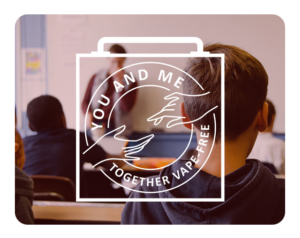
NEW! Tobacco Prevention Toolkit: Smokeless Tobacco 101
- Includes PowerPoint slide deck, factsheet, activities, online quiz games, worksheets, discussion guide for students to use with a trusted adult, and crash courses for educators
- Teaches the risks and history of smokeless tobacco use and refusal skills
- Includes 7 activities/mini-lessons organized by topic and placed in a recommended sequence, with a final unit Kahoot quiz. Project Here estimates 1-3 class sessions.

NEW! Tobacco Prevention Toolkit: Hookah 101
- Teaches the risks and parts of a waterpipe (hookah) and refusal skills
- Includes 5 activities/mini-lessons organized by topic and placed in a recommended sequence, with a final unit Kahoot quiz. Project Here estimates 1-2 class sessions.
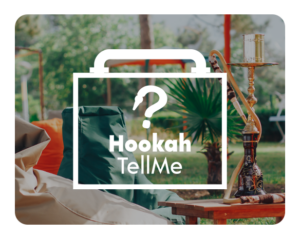
NEW! How Nicotine Affects the Teen Brain
- Includes teaching guide, student article, student activity sheet, vocabulary list, and optional interactive exercise
- Teaches about nicotine, its addictive properties, and the dangers of vaping, including by having students create a presentation for their peers
- Duration: 1 class period
- Standards aligned with: Common Core State Standards and Next Generation Science Standards
- Sources: National Institute on Drug Abuse (NIDA) & Scholastic

NEW! Teacher’s Guide to the Risks of Vaping Student Magazine
- Includes teacher’s guide (lesson plan), magazine “The Risks of Vaping,” Vaping 101 Articles, Vaping’s Not Our Thing project and project rubric
- Teaches about the risks of vaping by having students analyze informational texts to gather evidence and then create a persuasive anti-vaping infographic/poster for a teen audience
- Duration: 60 min
- Standards aligned with: Common Core State Standards ELA, Next Generation Science Standards, National Health Education Standards
- Sources: FDA Tobacco Education Resource Library
*Note: The materials in this lesson were previously part of Scholastic and the FDA’s “The Real Cost of Vaping” program (previously included in this Toolkit). The program was moved to the FDA Tobacco Education Resource Library and reworked into several separate lessons.
*Note: You will need to create a free account in the FDA Tobacco Education Resource Library to access resources.
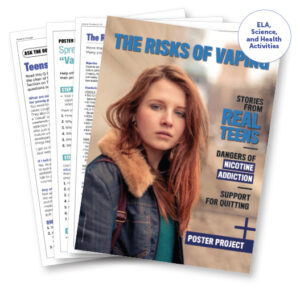
NEW! Teens and Vaping: The Real Health Consequences
- Includes lesson plan, Vaping 101 Articles, and Get the Facts About Vaping Activity
- Teaches about the health impacts associated with using e-cigarettes
- Duration: 50 min
- Standards aligned with: Common Core State Standards ELA and Next Generation Science Standards


NEW! Vaping Research Project
- Includes lesson plan, Vaping 101 Articles, and Plan an E-Cigarette Survey Activity
- Teaches students about the health consequences of e-cigarette use through a project where they design and conduct a survey at school
- Duration: 40 min
- Standards aligned with: Common Core State Standards Math & ELA, Computer Science, and Next Generation Science Standards
NEW! Sizing Up E-Cigarette Marketing
- Includes lesson plan, Vaping 101 Articles, Decode the Marketing Message Activities 1 & 2
- Teaches how to uncover the misleading ways e-cigarettes are marketed to teens
- Duration: 45 min
- Standards aligned with: Common Core State Standards ELA and Computer Science
Tobacco Prevention Toolkit: Nicotine Addiction
- Includes educator crash courses, PowerPoint with speakers notes, factsheets, and more
- Teaches students about the adolescent brain, addiction, and nicotine
- Duration: 3 class periods
- Source(s): Stanford Medicine

CATCH My Breath
- Includes 4 classroom lessons, virtual field trips, supplemental materials, free and paid teacher trainings, student self-paced modules, and paid video lessons
- Lessons teach the consequences of e-cigarette use, refusal skills and smart exit strategies, the role of advertising in e-cigarette use, and goal setting regarding e-cigarette use
- Duration: 4 35-min lessons
- Sample Lesson
- Sources: CATCH (Coordinated Approach to Child Health), The University of Texas Health Science Center at Houston School of Public Health
Note: The free curriculum is available to all U.S. schools. Click to register. Paid add-ons are also available.
E-Cigarettes: Is it Worth it?
- Includes educator/nurse instructional guide with instructions for 3 activities, 3 activity sheets for students, classroom poster, student toolkit, and parent/guardian letter
- Teaches the health risks of e-cigarette use and other tobacco product by looking at expert perspectives on tobacco use, advertising, and research
- Duration: 1-3 class periods
- Standard aligned with: National Health Education Standards, National Standards for Science in Personal and Social Perspectives, Common Core State Standards English Language Arts, History/Social Sciences, & Science
- Source(s): Young Minds Inspired, Campaign for Tobacco Free Kids, CVS Health
*Also available in Spanish
Taking Down Tobacco
- Includes teaching kit/lesson plan with instructions for 3 activities and follow-up, 3 activity sheets for students, classroom poster, 2 videos, parent/guardian letter, and student research resources
- Teaches about the risks of tobacco use and exposure to nicotine by reflecting on their personal experience with tobacco use, creating a PSA, and creating a poster about the impact of tobacco advertising
- Standards aligned with: National Health Education Standards, National Standards for Family and Consumer Sciences, Common Core State Standards English Language Arts, History/Social Sciences, & Science
- Source: Young Minds Inspired, Campaign for Tobacco Free Kids, CVS Health
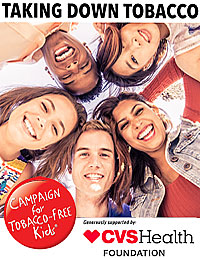
E-Cigarettes: What You Need to Know
- Includes lesson plan with student article, worksheet, critical thinking questions, vocabulary lists, and writing prompts
- Teaches about the potential risks of electronic cigarettes; how e-cigarette marketing strategies are designed and how they might influence teens; and, critical thinking
- Standards aligned with: Common Core State Standards, Next Generation Science Standards, National Science Education Standards, and National Council for Social Studies
- Source(s): National Institute on Drug Abuse (NIDA) & Scholastic
Know the Risks: A Youth Guide to E-cigarettes
- Includes a PowerPoint presentation and teacher talking points
- Educates youth on e-cigarettes, including health risks, the factors that lead to e-cigarette use, and what youth can do to avoid all tobacco products, including e-cigarettes
- Source: CDC’s Office on Smoking and Health (OSH)
Student Self-Paced Lessons
Vaping: know the truth.
- Grade level: 8
- Duration: 4 5-10 min lessons (total duration 30-40 min)
- Includes 4 self-led digital lessons with pre-and post-assessments and real-time score reporting
- Teaches students about the dangers of e-cigarette use and connects students who are currently using e-cigarettes to Truth Initiative’s text message quit vaping program, This is Quitting
- Standards: National Health Education Standards
- Source: EVERFI and Truth Initiative in collaboration with Kaiser Permanente and the American Heart Association
Note: Educators must create a free EVERFI Teacher account to get started and then invite students to their class using a unique registration code. This resource is free to use.
Additional Resources
New mind matters: the body’s response to nicotine, tobacco and vaping.
- Includes a student booklet and a Teacher’s Guide with suggested classroom activities
- Student booklet is available online (with video) or for download
- Explains what nicotine is, the health effects of nicotine, and what vaping devices are and how they work
- Sources(s): National Institute on Drug Abuse (NIDA)
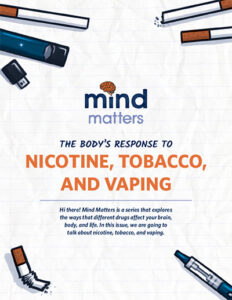
NEW! Tobacco Prevention Toolkit: Factsheets
- Includes multiple factsheets on e-cigarettes and vape pens, hookah and smokeless tobacco, and tobacco basics,
- Sources(s): Stanford Medicine
NEW! Fact: Vaping Harms Your Health (Infographic)
- Includes infographics for student “Fact: Vaping Harms Your Health”
- Sources(s): FDA Tobacco Education Resource Library
*Note: See below for 2 FDA Tobacco Education Resource Library infographics for parents/caregivers.
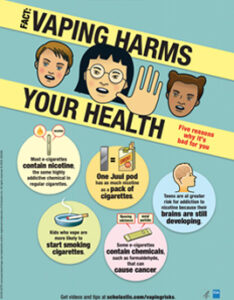
Resources for Parents & Caregivers
New fda tobacco education resource library infographics for parents & caregivers.
- Includes 2 infographics for parents/caregivers: “Vaping Facts and Misperceptions” and “How to Talk to Kids About Vaping Risks”
*Note: See above for an FDA Tobacco Education Resource Library infographics for students.
Vaping Fact Sheet
- Includes link to order vaping fact sheets
- Includes information that can be used throughout the community to inform parents about the dangers of vaping, data on youth e-cigarette use and the role of tobacco industry tactics
- Source(s): Massachusetts Health Promotion Clearinghouse
E-Cigarettes Shaped Like USB Flash Drives: Information for Parents, Educators, and Health Care Providers
- Includes infographic that gives an overview of E-cigarettes
- Provides brief description of the effects of e-cigarettes on the developing brain, and Helpful next steps for educators, parents, and health care providers about how to reduce the use of e-cigarettes among young people
- Source(s): Centers for Disease Control and Prevention (CDC)
Teachers and Parents: That USB Stick Might Be an E-Cigarette (Poster)
- Includes infographic with overview of e-cigarettes
- Focuses on summarizing e-cigarettes and their risks

An official website of the United States government
Here's how you know
Official websites use .gov A .gov website belongs to an official government organization in the United States.
Secure .gov websites use HTTPS A lock ( Lock Locked padlock ) or https:// means you’ve safely connected to the .gov website. Share sensitive information only on official, secure websites.
Vaping Prevention & Education
Lesson plan: vaping research project.
Students will carry out an investigation to collect and present data about their peers' knowledge and attitudes about e-cigarettes.
STANDARDS: 6TH – 12TH GRADE
- 6.SP.A.1 Recognize a statistical question as one that anticipates variability
- 6.SP.B.4 Display data, including using dot plots
- 7.SP.A Representative sampling and inferencing
- 8.SP.A.1 Construct and interpret scatter plots
- SL.4 Present claims and findings
- D4.1 Construct arguments using evidence
- Planning and Carrying Out Investigations
Vaping 101 Articles
Plan an E-Cigarette Survey Activity (A downloadable PDF is available here .)
LENGTH OF LESSON:
Activity: plan an e&nobreak;-&nobreak;cigarette survey.
Help students spread the word about the health consequences of e-cigarette use by designing and conducting a survey at school.
Explain that students will be conducting an anonymous survey to learn what their peers know about the health risks associated with e-cigarettes. Ask students to share questions they have, such as: How much nicotine is in most e-cigarettes? Record their questions on the board. As a class, brainstorm specific survey questions that could gain peer responses to their questions, such as: Did you know that the addictive chemical nicotine is in most e-cigarettes? Did you know the teen brain is even more vulnerable to addiction than the adult brain?
Separate the class into small groups. Distribute the Plan an E-Cigarette Survey activity sheet and have students complete steps 1 and 2. Remind them to work collaboratively and participate actively.
Review step 3 of the activity sheet as a class. Tell the class they will be creating aggregate data (grouped). To maintain student privacy, have students create a questionnaire sheet, make copies, and pass it out for peers to mark answers anonymously. Completed surveys can go in a cardbox or manila envelope, taped shut with a slit on top. Each group’s survey can be labeled with a keyword that is also written on their box or envelope. Emphasize the importance of being organized when collating data so that nothing gets duplicated or lost, rendering the data untrustworthy.
Discuss what a diverse, representative sample would look like across the school. In addition to considering gender and race, students should find a diverse mix of other students with various interests and sports or club participation, different friend groups, introverted and extroverted, etc.
Direct students to conduct their surveys and then analyze and graph their data. Finally, have each group create a presentation that clearly describes how the survey was conducted, uses visual elements to present their data, and includes conclusions they made based on their data.
- To support striving learners: Discuss what types of graphs would be more useful for displaying data.
- To increase the challenge: Have students compare their results with national surveys and consider why the data may be similar or different (e.g., sample size, concerns about anonymity, etc.).
Guide students to critically analyze each group’s presentation and assess how well the evidence supported the group's conclusions. Encourage them to be respectful while also providing constructive feedback. Some sentence starters you can use to guide them are:
- One thing they did well was…
- One thing they could improve on is…
- Something I learned that struck me was...
- A question I have is...
Wrap up by reading facts aloud from the Vaping Facts and Misperceptions infographic to help dispel any incorrect statements about e-cigarettes that may have arisen in survey presentations.
Have students use their data to create anti-vaping info cards. For example, if they found that their peers think e-cigarettes don’t contain nicotine, they should create a card explaining that they do (with source). Prompt them to choose facts and images that’ll make teens pay attention. Reproduce the cards for students to pass out or leave on lunch tables to spread the word.

IMAGES
VIDEO